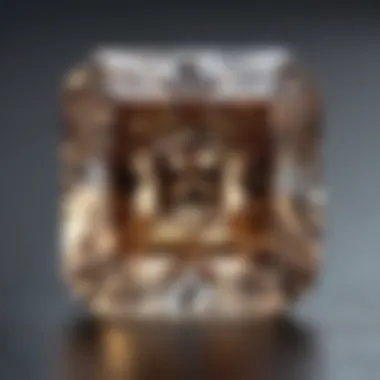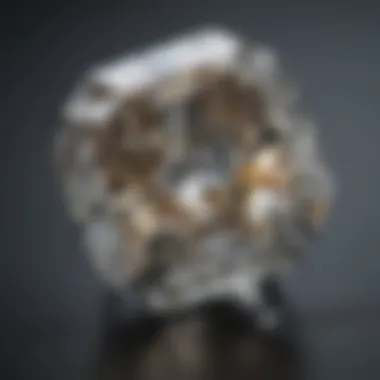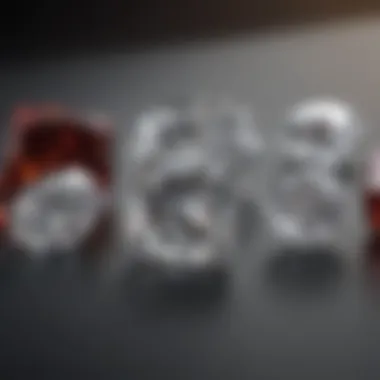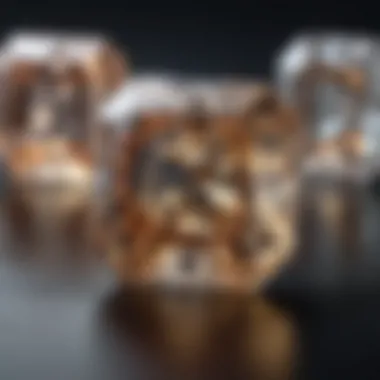Exploring 1 Carat Radiant Cut Diamonds: A Complete Guide


Intro
1 carat radiant cut diamonds represent a perfect blend of elegance and brilliance. As more buyers seek unique and striking stones, understanding the qualities of radiant cut diamonds is essential. These diamonds are characterized by their trimmed corners and a combination of brilliant and step cut facets. This creates a stunning interplay of light, enhancing their appeal.
This guide aims to explore various aspects of radiant cut diamonds. We will dive into their physical properties, grading criteria, and market trends, including insights for those interested in purchasing. Additionally, we will touch on their historical context and the emotional significance these stones hold in jewelry.
Understanding the elements surrounding radiant cut diamonds can lead to more informed buying decisions. The intricate facets, expert craftsmanship, and overall design choices greatly influence the stone's value.
Gemstone Overview
Description of the gemstone
Radiant cut diamonds were developed in the 1970s by Henry Grossbard. The immersive blend of both circular and square shapes results in a highly adaptable stone that suits various jewelry styles. While the perfect proportion varies, a 1 carat radiant diamond typically appears visually larger than its weight due to its facet arrangement and depth.
Physical properties
Radiant cut diamonds maintain several key physical traits. They feature:
- Cut: Angeled to maximize light return, giving exceptional brightness and fire.
- Clarity: Like all diamonds, the quality of clarity plays a significant role. It is classified by the presence of imperfections, which can affect how light interacts with the stone.
- Color: Radiant cut diamonds vary from colorless to near-colorless. The less color present, the higher the quality.
- Carat Weight: A 1 carat diamond weighs 0.2 grams, which is often the goal for many buyers seeking a balance between size and quality.
The unique characteristics of radiant cut diamonds make them ideal for various settings, particularly in engagement rings and statement pieces.
Grading Criteria
When assessing radiant cut diamonds, particularly 1 carat stones, the Four Cs are crucial:
- Cut: The overall excellence of the cut influences brilliance.
- Color: Evaluating the color can range from D (colorless) to Z (light yellow).
- Clarity: This evaluates visible inclusions or blemishes, with grades ranging from Flawless to Included.
- Carat: The weight of the diamond plays a significant role in its value, but how it looks can be more important.
"The allure of a diamond does not solely lie in its weight, but in the quality of its cut and light performance."
Historical Significance
Radiant cut diamonds have gained popularity since their inception. They are favored not only for their beauty but also for their ability to capture light, creating an enchanting sparkle. Their adoption by celebrities and influencers further propelled their visibility in the market, inspiring many couples to select radiant cuts for engagement rings.
Considerations for Buyers
For those looking to purchase a 1 carat radiant cut diamond, consider:
- Budget: Establish a range that you’re comfortable with. Radiant cuts can vary widely in price based on quality.
- Certification: Always buy from reputable dealers who provide certifications from recognized gemological laboratories like GIA or AGS.
- Personal Taste: Choose a diamond that resonates with personal style; color settings and ring designs greatly influence the visual appeal.
Prelude to Radiant Cut Diamonds
Understanding radiant cut diamonds is crucial for both gemstone enthusiasts and professionals alike. These diamonds combine the elegance of a traditional round cut with the unique shape and brilliance of a square. The radiant cut is known for its ability to reflect light effectively, creating a captivating sparkle. Thus, it appeals to those who appreciate both aesthetics and quality in diamond selection.
The 1 carat weight serves as a significant benchmark in the diamond market. At this weight, a radiant cut diamond strikes a balance between size and affordability, making it a popular choice. Knowing about these diamonds helps buyers make informed decisions regarding their purchases. This section addresses various facets, including the definition, historical context, and the reason why carat weight is important in assessing the value and appeal of radiant cut diamonds.


What is a Radiant Cut Diamond?
A radiant cut diamond is characterized by its distinct shape, which combines elements of both round and emerald cuts. These diamonds usually have 70 facets that maximize the stone's brilliance and fire. The result is a striking appearance that captivates onlookers. The corners are trimmed, giving it a softer edge than traditional square cuts, which enhance its visual appeal.
This type of diamond was developed in the late 1970s by Henry Grossbard, who sought to create a cut that would enhance light performance while maintaining a square shape. The unique blend of design and functionality has established the radiant cut as a timeless choice within the world of fine jewelry.
Historical Overview
The journey of the radiant cut diamond is intriguing. It was born out of the pursuit of innovation in diamond cutting techniques. Before the radiant cut, diamonds were predominantly round, oval, or marquise. The early years of the radiant cut were marked by experimentation. Over time, it gained popularity, becoming a desirable alternative for engagement rings and special occasions.
Henry Grossbard's creation aimed to achieve maximized light reflection. This focus on brilliance set the stage for the radiant cut to capture the attention of jewelers and customers alike. Today, the radiant cut stands as one of the most sought-after diamond shapes, recognized for its blend of brilliance and unique artfulness.
Significance of Carat Weight
Carat weight is a critical factor in determining a diamond's value. A 1 carat radiant cut diamond often represents a balanced mix of size and price, appealing to budget-conscious buyers. Carat weight impacts not only the physical dimensions but also the diamond's perceived brilliance.
While larger diamonds are generally more expensive, a well-proportioned 1 carat radiant cut can appear larger than its weight suggests. This is due to the cut's excellent light performance, which enhances its visual impact. Understanding carat weight is essential for buyers who want to ensure they get a stone that meets their preferences without overspending.
Characteristics of Carat Radiant Cut Diamonds
Understanding the characteristics of 1 carat radiant cut diamonds is essential for both gem enthusiasts and collectors. Radiant cut diamonds, known for their unique combination of rectangular and round features, offer a distinct allure that many find appealing. The focus of this section centers on three key areas: proportions and dimensions, cut quality, and light performance. Each of these elements plays a significant role in the overall beauty and value of the diamond.
Proportions and Dimensions
The proportions and dimensions of a 1 carat radiant cut diamond are fundamental to its appearance. Unlike other shapes, the radiant cut has a unique ratio that balances both length and width. Ideally, the length-to-width ratio should range from 1.00 to 1.05 for a square appearance, or between 1.50 and 1.75 for a more rectangular look. This ratio influences how the cut interacts with light.
Several dimensions impact the diamond's appearance:
- Table Size: The table should be moderately sized, typically between 55% and 65% of the circumference, to ensure balance in brilliance and fire.
- Depth Percentage: Ideal depth ranges between 58% and 64%. Too deep or too shallow can affect light reflection, detrimental to sparkle.
These cutting standards are essential to achieving optimal visual effects in a 1 carat diamond. A well-cut radiant diamond will exhibit symmetrical facets and proper alignment, enhancing its desirability.
Cut Quality and Its Impact
Cut quality is arguably one of the most pivotal factors influencing a diamond's aesthetic appeal. The cut determines how light enters and exits the stone, affecting brilliance and fire. For a 1 carat radiant cut diamond, assessing cut quality is not just about appearance but also overall value. A diamond with an excellent cut grade will reflect light more effectively than one with a poor cut grade.
Several classifications exist for cut quality:
- Excellent: Exceptional light performance, usually with superior proportion and symmetry.
- Very Good: High quality, but may have minor variations.
- Good: Adequate appearance with noticeable imperfections.
- Fair and Poor: Generally lacks brilliance and charm, often avoided by buyers.
Investing time to examine cut quality can drastically influence the selection process for buyers. A diamond with outstanding cut quality will always retain its value better than lesser cuts.
Light Performance
Light performance is a critical characteristic that defines the allure of 1 carat radiant cut diamonds. The way light interacts with the facets creates a dazzling display of brilliance and fire.


In evaluating light performance, three primary attributes must be considered:
- Brilliance: This refers to the white light reflected from the diamond's surface and interior. The arrangement of facets plays a crucial role in how effectively light returns to the eye.
- Fire: The dispersion of light into colors creates a beautiful display. A high-quality radiant cut maximizes this effect, leading to captivating visual experiences.
- Scintillation: This is the sparkle seen when the diamond moves, caused by reflections from the facets. Proper alignment enhances scintillation.
"The magic of a radiant cut lies in its ability to blend light and shape, creating a captivating visual melody that is unique to each diamond."
By understanding light performance, buyers can better appreciate the inherent beauty of their diamond choice. Overall, characteristics such as proportions, cut quality, and light performance greatly influence a diamond's value and appeal.
The Value of Carat Radiant Cut Diamonds
The value of a 1 carat radiant cut diamond encompasses several important factors, including market trends, pricing, and its comparison with other cuts. Understanding these elements is crucial for both enthusiasts and potential buyers. The radiant cut diamond, celebrated for its unique amalgamation of elegance and brilliance, is not only an aesthetic choice but also an investment. The valuation of these diamonds fluctuates based on changing market dynamics and consumer preferences. However, recognizing these nuances can enhance one's appreciation and decision-making process when purchasing a diamond.
Market Trends and Pricing Factors
The market for radiant cut diamonds has seen fluctuations influenced by several key factors. First, consumer trends play a significant role. Increased awareness and appreciation for radiant cuts, especially among younger generations, has led to higher demand. Social media platforms and influencers have spotlighted this shape, contributing to a rising popularity.
Additionally, the broader economic conditions impact pricing. Economic stability often correlates with increased discretionary spending, allowing more consumers to invest in higher-quality gemstones. In contrast, during financial uncertainty, luxury items like diamonds may see a dip in demand, which consequently affects prices.
Other pertinent factors include:
- Quality of the Cut: A well-cut radiant diamond demonstrates superior light performance, enhancing its value.
- Color and Clarity Grades: Higher grades for these attributes can significantly increase price.
- Sourcing: Ethically sourced stones often carry a premium.
"Market evolution reflects changes in societal preferences and economic factors, making it essential to stay informed."
Comparative Analysis with Other Cuts
When comparing radiant cut diamonds with other popular shapes—such as round, princess, or cushion cuts—important differences emerge. Radiant cuts are distinguished by their unique facet arrangement, enhancing light reflection and brilliance. In contrast, a round cut tends to have a more uniform brilliance due to its symmetrical design. While the round cut remains the most popular and, often, the most expensive shape, radiant cuts are gaining traction for their exquisite play of light.
Some comparisons include:
- Brilliance: Radiant cuts can exhibit high levels of sparkle due to their faceting.
- Shape Versatility: The radiant cut often appeals to those looking for a blend of traditional and modern aesthetics.
- Availability: The market may have larger inventories of well-graded options for popular cuts like the round.
Selecting the Right Carat Radiant Cut Diamond
Choosing the correct 1 carat radiant cut diamond is pivotal for making a wise investment. Radiant cut diamonds uniquely combine the elegance of the round shape with the traditional appeal of the emerald cut. They offer brilliance and fire which appeals to many buyers. However, the process of selecting one involves knowledge of various factors to ensure that you obtain a stone that meets your aesthetic and quality preferences.
Understanding Grading Systems
Diamonds are evaluated based on the Four Cs: Carat weight, Cut, Color, and Clarity. This grading system is crucial for understanding what you are purchasing. For a 1 carat radiant cut diamond, each of these elements matters.
- Carat Weight: Represents the size of the diamond. While 1 carat is the standard for this discussion, how the weight is distributed affects perceived size.
- Cut: A radiant cut should have excellent cut quality to maximize light performance. Depth and table percentages are vital for aesthetic appeal.
- Color: Radiant cuts can show color more so than some other shapes. Opt for a diamond near colorless for best brilliance.
- Clarity: Look for stones that have minimal inclusions, which can hinder light reflection, thus impacting fire and sparkle.
Educating yourself on these grading elements allows you to confidently assess options in the market.
Key Considerations for Buyers


When looking for a 1 carat radiant cut diamond, several considerations should guide your decision. Buyers should focus on different aspects to ensure satisfaction with their choice.
- Certification: Always choose diamonds that come with a grading report from reputable labs like the Gemological Institute of America (GIA) or the International Gemological Institute (IGI). This ensures that the diamond has been thoroughly evaluated.
- Budget: Establish a budget before shopping. This will help narrow down the choices and prevent overspending.
- Radiant Cut Characteristics: Pear-shaped and square-shaped radiants will behave differently with light. Be sure to choose one that resonates with your personal style.
- Trustworthy Retailers: Purchase from established and reputable jewelers who provide transparent information on their diamonds. Avoid unverified sellers to minimize risks.
Focusing on these key considerations can save time and enhance your overall buying experience.
Sourcing and Certification
The sourcing process of a diamond is critical in ensuring its authenticity and ethical origin. Repudiating conflict diamonds is essential to many buyers, making responsible sourcing key in this day and age.
- Ethical Sourcing: Look for retailers who adhere to the Kimberly Process, which ensures that diamonds are conflict-free. This adds value and ensures ethical responsibility in your purchase.
- Certification: The certification process provides reassurance regarding the quality of the stone. Trusted organizations such as GIA or IGI validate the grading and attributes of the diamond. Knowing that the diamond complies with industry standards will enhance your confidence in making the investment.
Caring for Your Radiant Cut Diamond
Caring for a 1 carat radiant cut diamond is critical for maintaining its beauty and integrity over time. This section delves into the crucial aspects of maintenance and cleaning, as well as storage recommendations. Proper care not only enhances the diamond's appearance but also preserves its value, making it essential for both collectors and wearers.
Maintenance and Cleaning Tips
Regular cleaning is vital for any diamond. Radiant cut diamonds can accumulate dirt, oils, and other residues that dull their sparkle. To clean your diamond, follow these simple steps:
- Use a Soft Brush: A soft-bristled toothbrush can reach crevices without damaging the diamond or its setting.
- Mild Soap Solution: Mix warm water with a few drops of mild dish soap. Soak the diamond for about 20 to 30 minutes.
- Gentle Scrubbing: After soaking, gently brush the diamond to remove any remaining dirt. Rinse it under cool running water to wash away soap.
- Drying: Use a lint-free cloth to gently pat dry. Avoid using paper towels as they might scratch the surface.
Cleaning frequency varies depending on the environment. If you wear your diamond frequently, clean it every few weeks. If it’s stored more than worn, a monthly cleaning should suffice. It is also advisable to have a professional check the settings at least once a year.
Storage Recommendations
Storing your radiant cut diamond properly is key to protecting it from scratches and other damage. Here are some effective storage tips:
- Separate Storage: Always store your diamond separately from other jewelry items. This prevents scratching from harder metals or gemstones.
- Use a Jewelry Box: A dedicated jewelry box with compartments is ideal. Ensure it has a soft lining, such as velvet, to cushion the diamond.
- Avoid Exposure to Chemicals: Keep your diamond away from household cleaning products or any harsh chemicals that could damage its sparkle.
- Climate Control: If possible, store your diamond in a climate-controlled environment to prevent temperature extremes that could affect the stone or its setting.
Proper care can extend the life and brilliance of your radiant cut diamond, ensuring that it remains a treasured possession.
In summary, maintenance and careful storage are essential practices for preserving the beauty of 1 carat radiant cut diamonds. With correct handling, these diamonds can retain their stunning appearance for generations, making them valuable heirlooms.
End
The conclusion of this article serves as an essential capstone to the extensive exploration of 1 carat radiant cut diamonds. It synthesizes the unique characteristics, value assessments, and care tips that have been discussed. Understanding these elements is crucial for both enthusiasts and buyers navigating the complex diamond market.
Aspects such as cut quality and light performance have been shown to significantly influence a diamond's appeal and value. A 1 carat radiant cut diamond, while not the largest, holds a position of distinction due to its balance of size and brilliance. Buying such a diamond involves careful consideration of grading and sourcing, ensuring the diamond not only meets aesthetic desires but also serves as a worthwhile investment.
In summary, it is vital for buyers to remain informed about market trends and pricing factors, as this knowledge directly affects their purchasing power. Armed with the insights outlined in this article, one can approach the acquisition of a radiant cut diamond with confidence.
Final Thoughts on Carat Radiant Cut Diamonds
A 1 carat radiant cut diamond can be a profound choice for various occasions, from engagements to significant anniversaries. The ideal interplay of proportions, light performance, and cut quality makes these diamonds intriguing in the broader spectrum of gemstones.
- The versatility of the radiant cut allows it to complement various jewelry styles, making it suitable for modern and vintage preferences alike.
- Comparing it with other cuts reveals its distinct advantages; radiant cut diamonds often exhibit superior brilliance, which can capture the observer’s attention more effectively.
"A diamond is only as brilliant as its cut, and the radiant cut shines uniquely, combining elegance with striking visual appeal."
Moreover, discerning buyers will find value in understanding grading systems and focusing on certified sources to ensure authenticity and quality. Proper care, as covered in previous sections, is also vital for maintaining the diamond's beauty over time.







